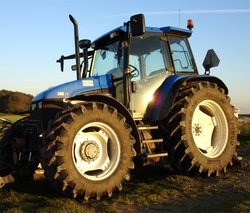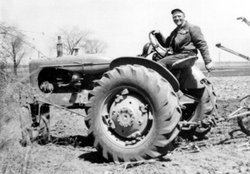Tractor
|
|

A tractor (from Latin trahere "to pull") is a device intended for drawing, towing or pulling something which cannot propel itself and, often, powering it too. Most commonly the word is used to describe a vehicle intended for such a task on some other vehicle or object.
| Contents |
Farm tractor

The most common use of the term tractor is for the vehicles used on farms. The farm tractor is used for pulling agricultural machinery or trailers, for ploughing, harrowing and similar tasks. The classic farm tractor is a simple open vehicle with two very large driving wheels on an axle below and slightly behind a single seat (the seat and steering wheel consequently are in the center) and the engine in front of the driver with two steerable wheels below the engine compartment. This basic design has remained unchanged for a number of years, but now enclosed cabs are available for many models of farm tractor.
There are usually three foot-pedals, for the operator, on the floor of a tractor. The pedal on the left is the clutch. The operator presses on this pedal to disengage the transmission for either shifting gears or stopping the tractor. The two pedals on the right are the brakes. The left brake pedal stops the left rear wheel and the right brake pedal does the same with the right side. This independent left and right wheel braking augments the steering of the tractor. This is usually done when it is necessary to make a tight turn. The operator presses both pedals together to stop the tractor. The split brake pedal is also used in mud or soft dirt to control a tire that spins due to loss of traction.
Benin_brown_tractor_600.jpg
The throttle, unlike those in automobiles, is generally controlled from a hand-operated lever. This helps provide a constant speed in field work. It also helps provide continuous power for stationary tractors that are operating an implement by shaft or belt. Some modern tractors have an additional pedal on the floor that serves as an additional throttle control giving the operator more like automobile-control over the speed of the tractor for road work.
Most farm tractors use a manual transmission. They have several gears which generally provide a range of speeds from less than a mile per hour up to about 25 miles per hour. Compared to other vehicles the tractor is quite slow. Slower speeds are necessary for most operations that are performed with a tractor. These slower speeds help give the farmer a larger degree of control in certain situations—such as field work. Older tractors generally require that the operator press in the clutch to shift the gears but many modern tractors can shift between certain gears without the need to depress the clutch. The former was a limitation of straight-cut gears in the gearbox, the latter an advance so that the operator can have more control over working speed than just the throttle.
Modern farm tractors range in size from 18 to 500 horsepower (15 to 400 kW). Tractors can be generally classified as two wheel drive, two wheel drive with front wheel assist, or four wheel drive (with articulated steering). Variations of the classic style include the diminutive lawn tractors and their more capable and ruggedly constructed cousins garden tractors,which tend to range from 10 to 25 horsepower and are used for smaller farm tasks, mowing grass, and landscaping. The size - especially with modern tractors - and the slower speeds are reasons motorists are urged to use caution when encountering a tractor on the roads.
Modern tractors have roll over protection systems (ROPS) to prevent an operator from being crushed in the event of a rollover. This is especially important in open-air tractors. In open-air tractors the ROPS is a steel beam that extends above the operator's seat. For tractors with operator cabs, the ROPS is part of the frame of the cab. Before ROPS were required many farmers died when their tractors rolled over on top of them. Row-crop tractors, before ROPS, were particularly dangerous because of their 'tricycle' design with the two front wheels spaced close together and pointed inward toward the ground. Many farmers were killed by rollovers while operating tractors along steep slopes. ROPS were first required by legislation in New Zealand in the 1960s.
TractorPTOshaftMay04.jpg
Most tractors have a means to transfer the engine's power to another machine such as a baler or mower. Early tractors used belts wrapped around pulleys to power stationary equipment. Modern tractors use a power take-off shaft (PTO) to provide rotary power to machinery that may be stationary or pulled. Almost all modern tractors can also provide hydraulic and electrical power.
Farm implements can be attached to the rear of the tractor by either a drawbar or by a three-point hitch. The three-point hitch was invented by Harry Ferguson and has been a standard since the 1960s. Equipment attached to the three-point hitch can be raised or lowered hydraulically with a control lever. The equipment attached to the three-point hitch is usually completely supported by the tractor.
Engineering tractors
The durability and engine power of tractors made them very suitable for engineering tasks. Tractors can be attached with different engineering tools such as dozer blade, bucket, hoe, ripper and so on. The most common attachments for the front of a tractor are dozer blade or a bucket. When attached with engineering tools the tractor is called an engineering vehicle.
A bulldozer is a tracked-type tractor attached with blade in the front and a rope-winch behind. Bulldozers are very powerful tractors and have excellent ground-hold, as their main tasks are to push or drag things.
Bulldozers have been further modified over time to evolve into new machines which are capable of working in ways that the original bulldozer can not. One example is that loader tractors were created by removing the blade and substituting a large volume bucket and hydraulic arms which can raise and lower the bucket, thus making it useful for scooping up earth, rock and similar loose material to load it into trucks.
A front-loader or loader is a tractor with an engineering tool which consists of two hydraulic powered arms on either side of the front engine compartment and a tilting implement. This is usually a wide open box called a bucket but other common attachments are a pallet fork and a bale grappler.
Other modifications to the original bulldozer include the reduction in size of the machine to permit it to operate in small work areas where movement is limited. There are also tiny wheeled loaders, officially called Skid-steer loaders but nicknamed "Bobcat" after the original manufacturer, which are particularly suited for small excavation projects in confined areas.
Backhoe loader
The most common variation of the classic farm tractor is the loader-backhoe, also called a backhoe-loader. As the name implies, it has a loader assembly on the front and a backhoe on the back. When both the loader and the backhoe are permanently attached it is almost never called a tractor, not generally used for towing and usually does not have a PTO. When the backhoe is permanently attached, the machine usually has a seat that can swivel to the rear to face the hoe controls. Removable backhoe attachments almost always have a separate seat on the attachment itself.
Backhoe-loaders are very common and can be used for a wide variety of tasks: construction, small demolitions, light transportation of building materials, powering building equipment, digging holes, breaking asphalt and paving roads. Some buckets have a retractable bottom, enabling them to empty their load more quickly and efficiently. Retractable-bottom buckets are also often used for grading and scratching off sand. The front assembly may be a removable attachment or permanently mounted. Often the bucket can be replaced with other devices or tools.
Their relatively small frame and precise control make backhoe-loaders very useful and common in urban engineering projects such as construction and repairs in areas too small for larger equipment. Their versatility and compact size makes them one of the most popular urban construction vehicles.
Other types of tractors
The term tractor is applied also to:
- road tractor
- heavy-duty vehicles with large engines and several axles. These tractors are designed to pull long road trailers, most often for the transport of freight of some kind over a significant distance (See Semi-trailer).
Backing_it_in_2.jpg
- locomotive tractor (engines)
- the amalgamation of machines, generators, controls and devices that comprise the traction component of railway vehicles
UP_Diesel.jpg
Tractors, agriculture and aerospace
In aircraft, a tractor configuration refers to the propellers being in front of the fuselage or wing. Conversely, if to the rear, it is a called a pusher configuration.
NASA and other space Agencies use very large tractors to ferry launch vehicles like booster rockets and space shuttles from their hangars to (and in rare cases, from) the launchpad .
Space technology has also trickled back down to agriculture in the form of GPS devices, and robust on-board computers installed as optional features on farm tractors. The spin-offs from the space race have actually facilitated automation in plowing and the use of driverless drone tractors that work in tandem with manned tractors on large corporate-scale farms.
Virtual tractors
One might also ponder the futuristic probability of the tractor beam and other means to achieve traction in the low gravity of virtually empty space as Humans begin to mine the asteroid belt and plant crops on the Moon and Mars More practical, is the cyberspace expansion of the term to include file or packet tractors within the transport layer of the OSI Model. This falls into the budding field of internet mechanics evolving conceptually from the tractor as a part of a printer that transports paper through the printer. Compare the adaptation of the term TTY still in use long after the Teletype machine faded into obsolescence.
See also
- List of farm implements
- Backhoe loader
- Bulldozer
- Crane
- Engineering vehicles
- Excavator
- Grader
- Front loader
- Skid loader
- Space technology
External links
- Tractors in the 1930's (http://www.livinghistoryfarm.org/farminginthe30s/machines_04.html)
- Antique Tractors (http://www.antiquetractors.com/index.htm)
- Howstuffworks.com: How a backhoe loader works (http://home.howstuffworks.com/backhoe-loader.htm)
- Thinking around the problems (http://www.pukeariki.com/en/stories/inventions/loubutler.asp)
- WebFarmer.com (http://www.webfarmer.com/)
- Tractor Implements and Backhoes (http://www.kpxtractors.com/)sr:Трактор
bs:Traktor de:Traktor eo:Traktoro es:Tractor he:טרקטור la:Tractor nl:Tractor nds:Trecker pl:Ciągnik sv:Traktor


